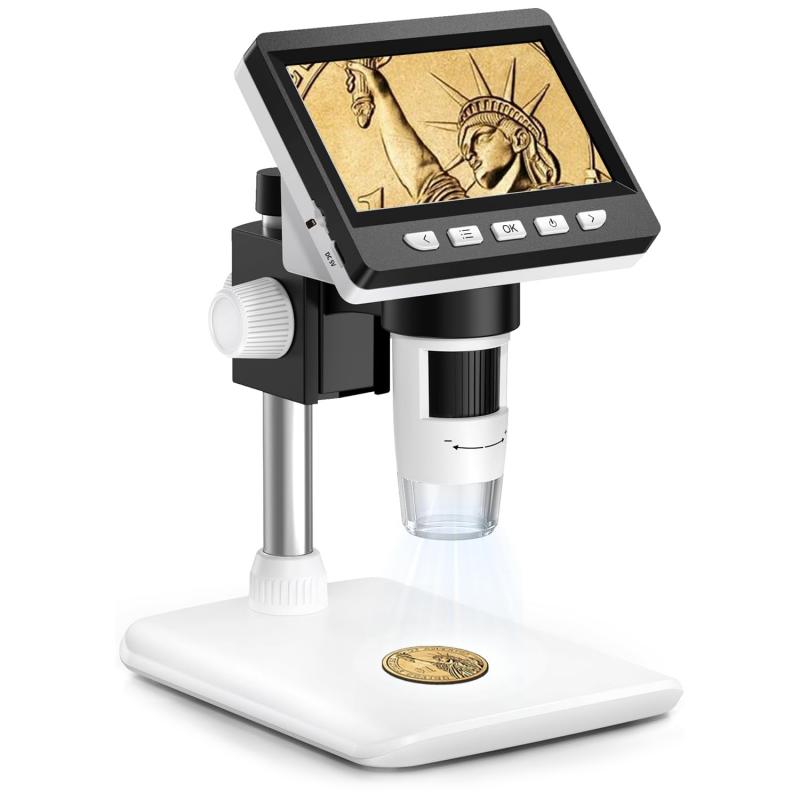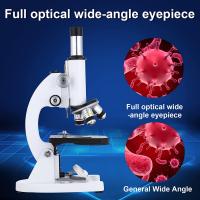How To Look At Cells Under A Microscope ?
To look at cells under a microscope, first prepare a microscope slide by placing a thin slice of the specimen on it. Add a drop of a suitable stain or a mounting medium if necessary. Place the slide on the stage of the microscope and secure it with the stage clips. Start with the lowest magnification objective lens and use the coarse focus knob to bring the cells into approximate focus. Then, use the fine focus knob to sharpen the image. Adjust the condenser and diaphragm to optimize the lighting. Once you have a clear view, you can switch to higher magnification lenses to observe the cells in more detail. Remember to always handle the microscope and slides with care to avoid damage.
What is the structure of DNA?
1、 Microscope Basics: Understanding the Parts and Functionality
To look at cells under a microscope, you need to have a basic understanding of the parts and functionality of the microscope. Here is a step-by-step guide on how to do it:
1. Prepare your microscope: Start by placing the microscope on a stable surface and ensuring it is clean and free from dust. Adjust the light source to provide adequate illumination.
2. Prepare your sample: Take a small sample of the cells you want to observe and place it on a glass slide. Add a drop of a suitable staining solution if necessary, to enhance the visibility of the cells.
3. Adjust the objective lens: Begin with the lowest magnification objective lens (usually 4x or 10x) and position it over the sample. Use the coarse adjustment knob to bring the lens close to the slide without touching it.
4. Focus the image: Look through the eyepiece and use the fine adjustment knob to bring the cells into focus. Start with a coarse adjustment and then fine-tune it until the cells appear clear and sharp.
5. Observe and analyze: Once the cells are in focus, you can observe and analyze their structure, shape, and any other characteristics of interest. You can also switch to higher magnification objective lenses (40x, 100x) to get a closer look at the cells.
It is important to note that the latest advancements in microscopy techniques, such as confocal microscopy and super-resolution microscopy, have revolutionized the field of cell imaging. These techniques allow for higher resolution and three-dimensional imaging of cells, providing researchers with more detailed information about cellular structures and processes. However, the basic steps mentioned above still apply when using these advanced microscopy techniques.

2、 Sample Preparation: Fixation, Staining, and Mounting Techniques
To look at cells under a microscope, it is essential to follow proper sample preparation techniques, including fixation, staining, and mounting. These steps ensure that the cells are preserved, visible, and ready for observation. Here is a step-by-step guide on how to prepare cells for microscopic examination:
1. Fixation: Fixation is the process of preserving cells in their natural state. It involves treating the cells with a fixative solution, such as formaldehyde or methanol, to immobilize and stabilize their structures. This step prevents cell degradation and maintains their morphology.
2. Staining: Staining is crucial for enhancing cell visibility and highlighting specific structures or components. Various staining techniques can be used, such as immunostaining, which uses antibodies to target specific proteins, or fluorescent dyes that bind to specific cellular components. Staining allows for better differentiation and identification of different cell types or structures.
3. Mounting: After staining, the cells need to be mounted onto a slide for observation. A mounting medium, such as glycerol or a commercial mounting medium, is used to secure the cells and prevent them from moving during microscopy. The mounting medium also helps to preserve the stained cells for long-term storage.
It is important to note that the latest advancements in sample preparation techniques have focused on improving the preservation of cellular structures and minimizing artifacts. For example, new fixation methods, such as cryofixation or high-pressure freezing, have been developed to better preserve cellular ultrastructure. Additionally, advanced staining techniques, such as super-resolution microscopy and live-cell imaging, allow for more detailed and dynamic visualization of cellular processes.
In conclusion, proper sample preparation techniques, including fixation, staining, and mounting, are essential for observing cells under a microscope. These techniques have evolved over time, incorporating new methods to improve cell preservation and visualization. By following these steps, researchers can obtain accurate and detailed information about cellular structures and functions.

3、 Adjusting Microscope Settings: Focus, Magnification, and Illumination
To look at cells under a microscope, you need to follow a few steps to ensure proper focus, magnification, and illumination. Here is a guide on how to do it:
1. Prepare the microscope: Start by placing the microscope on a stable surface and plugging it in if necessary. Make sure the microscope is clean and free from any debris or dust.
2. Adjust the lighting: Turn on the microscope's light source and adjust the intensity of the light. Too much or too little light can affect the visibility of the cells. Use the condenser to control the amount of light reaching the specimen.
3. Choose the appropriate objective lens: Microscopes have different objective lenses with varying magnification powers. Start with the lowest magnification lens (usually 4x or 10x) to locate the cells and then switch to higher magnification lenses (40x or 100x) for more detailed observations.
4. Focus the specimen: Place the slide with the cells on the stage and secure it with the stage clips. Use the coarse adjustment knob to bring the cells into rough focus. Then, use the fine adjustment knob to fine-tune the focus and obtain a clear image of the cells.
5. Adjust the magnification: Rotate the nosepiece to switch between different objective lenses. Each lens will provide a different level of magnification. Start with the lowest magnification and gradually increase it to observe the cells in more detail.
6. Observe and record: Once the cells are in focus, observe their structure, shape, and any other relevant features. You can use the microscope's built-in camera or attach a digital camera to capture images or videos of the cells for further analysis or documentation.
It is important to note that the latest advancements in microscopy technology, such as confocal microscopy and super-resolution microscopy, offer even higher resolution and more detailed imaging of cells. These techniques allow scientists to study cellular structures and processes with unprecedented clarity and precision.

4、 Observing Cell Structures: Nucleus, Cytoplasm, and Organelles
To look at cells under a microscope and observe their structures, follow these steps:
1. Prepare a microscope slide: Place a thin slice of the specimen you want to observe on a clean glass slide. You may need to stain the cells to enhance their visibility, depending on the type of cells you are studying.
2. Set up the microscope: Turn on the microscope and adjust the light intensity to a comfortable level. Start with the lowest magnification objective lens (usually 4x or 10x) and place the slide on the stage. Secure it with the stage clips.
3. Focus on the cells: Use the coarse adjustment knob to bring the cells into rough focus. Then, use the fine adjustment knob to sharpen the image. Move the slide around to locate the area of interest.
4. Observe the nucleus: The nucleus is usually the most prominent structure in a cell. It appears as a dark, round or oval-shaped region within the cell. Take note of its size, shape, and any visible structures within it, such as the nucleolus.
5. Examine the cytoplasm: The cytoplasm surrounds the nucleus and appears as a lighter, granular region. Observe its consistency, color, and any visible structures, such as granules or vacuoles.
6. Identify organelles: Look for other organelles within the cell, such as mitochondria, endoplasmic reticulum, Golgi apparatus, and lysosomes. These structures may appear as small, distinct bodies within the cytoplasm.
7. Increase magnification: If necessary, switch to higher magnification objective lenses (40x or 100x) to observe finer details of the cell structures. Remember to adjust the focus accordingly.
It is important to note that the latest advancements in microscopy techniques, such as confocal microscopy and super-resolution microscopy, allow for even more detailed observation of cell structures. These techniques provide higher resolution and three-dimensional imaging, enabling scientists to study cellular processes with greater precision.





































